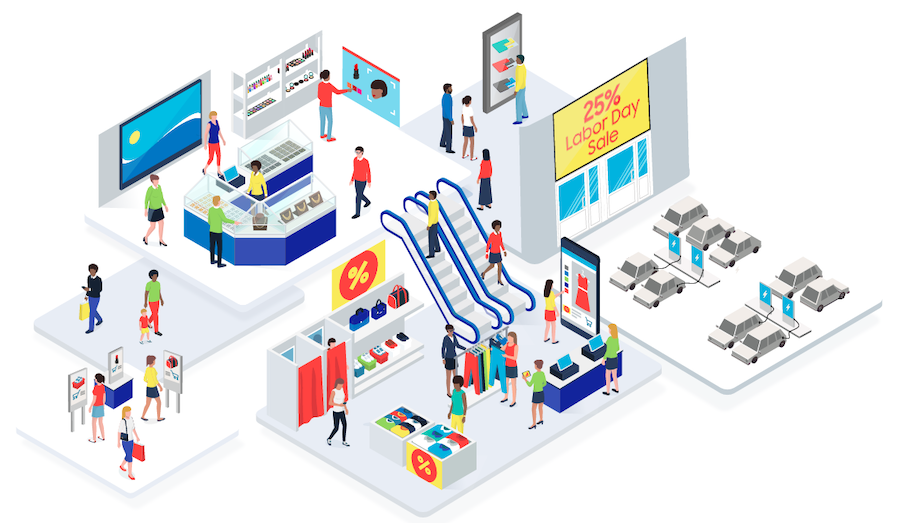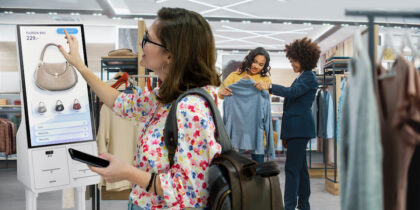In response to evolving consumer purchasing patterns, retailers with digital solutions in place — particularly AI-powered ones — are examining shopping habits and how retail data can be used in real time.
Today’s retailers must engage customers in new and different ways. In order to compete with the industry’s behemoths, they need to create a satisfying customer journey online and in the store. Blending the two into a memorable omnichannel retail media experience is essential for success in today’s digital world, but to do it, retailers need a powerful retail content management system (CMS). Here’s why.
Immersive omnichannel tech with AI
Can retail data be used in real time? Yes. With digital tools like in-store analytics, 3D modeling, intelligent displays and heat sensors, retailers are tracking customers’ behavior in their stores to up their service game. The goal is to make the customer journey — which often begins at home or on their phone — so intuitive and convenient that what they remember most is the enjoyable, safe experience they had at your store. AI helps to level up that journey by making sense of the data pulled from consumer behavior and pointing to ways to use it.
Personalize the customer journey
Many retailers assume they know how consumers move through their stores or where shoppers spend the most time, but it’s hard to know for sure without the data. Heat mapping can use retail data in real time, identifying critical opportunities in the conversion funnel and helping retailers make well-informed decisions. Using AI-powered machine learning, FastSensor technology gathers traffic insights from physical data points inside a store and sends them to a cloud-based server. From there, the data sets are analyzed according to an algorithm and converted into actionable items that can be implemented inside the store.
How digitizing retail experiences boosts ROI
Explore customer behavior with and the operational benefits of a complete digital retail ecosystem. Download Now
With this technology, sensors can “see” a customer in front of a certain item and then display relevant on-shelf messaging, such as discount codes, photos and reviews of the product, as well as complementary items, warranty offers or even a short video of the product in use. Businesses can build custom solutions based on their specific needs, growth goals and KPIs. Over time, FastSensor helps retailers gather, analyze and deliver data points, which you can use to continually reoptimize your displays.
Create, manage and distribute content
Retailers must deliver relevant, engaging and up-to-the-minute content exactly when their customers need it. Samsung VXT, an intuitive CMS, is a game-changer for busy operators who don’t have time to manually troubleshoot every technical issue. With a single intuitive platform, you can create, publish and manage content in real time.
For instance, retailers might use Samsung VXT to announce limited-time offers, showcase new inventory and alert in-store shoppers of an upcoming weather event. It also allows retailers to automate tasks and schedule upcoming promotions. Samsung VXT can help shrink your company’s carbon footprint by drastically reducing how many printed materials you use. The cost of overhead drops, too, as all content and displays can be managed from one location.
With Samsung VXT, operators can view real-time in-store analytics and detailed marketing performance reports. Its comprehensive technical support and regular software upgrades ensure retailers always have a robust marketing toolkit at their fingertips.
Maximize throughput with 3D mapping
Knowing how customers move about the store helps retailers create more compelling customer journeys and incorporate strategic points of engagement.
If a retailer discovers — through 3D heat mapping, for instance — that their store layout isn’t fully optimized, they can use that data to reorganize the store. This mapping takes the guesswork out of store design and conversion optimization by allowing operators to compare detailed before-and-after data analytics for retail.
For example, grocery stores often place popular items like milk, beer and diapers near the back of the store to encourage impulse purchases along the way. When you know which aisles customers are most likely to use to get there, you can optimize your displays and messaging on those paths.
What’s next for AI and data in retail?
With AI-powered retail media solutions, stores can blend the ease of online shopping with the convenience of picking up items in person — and that’s where Samsung comes in.
By integrating seamlessly with retail software, digital signage from Samsung can entice window shoppers to come inside, at which point heat mapping and sensors can track their journey and see where they linger and for how long. Smart displays can also boost upsells by providing relevant suggestions based on a customer’s location in the store, the time of day, season or other custom triggers — for example, recommending LED bulbs when a customer purchases a light fixture.
As brick-and-mortar stores evolve to take on new challenges, retailers have been forced to innovate. Embracing digital solutions will help them meet their customers’ needs.
Sign up for a VXT free trial here. Get more tips on configuring and tailoring real-time messaging using an integrated management system, such as Samsung VXT, in this complete guide. You can find more innovative signage solutions for in-store shopping by exploring Samsung’s full retail display lineup.








